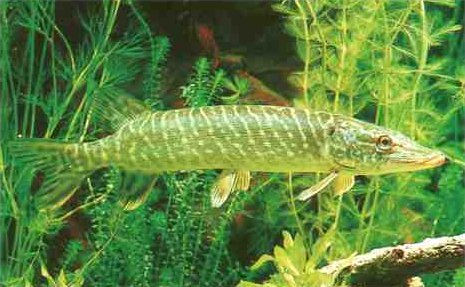Reproduction
The dirty business,
that's right sexual reproduction, though there will be no
intercourse for the Esox lucius species. Reproduction
in these magnificent creatures is one that makes for a lot of
young and bad parenting.
The northern pike species is diecous, meaning that the male
and female are separate organisms. Life starts with the female
and her eggs, for the northern pike that may be up to 12,000
eggs per pound of the female. This seems like a large number for
a fish but to reason it out a bit 15 to 20 percent of the
females body weight is the female gonad. The female gonad looks like
two pair shapes that are orange, these are the ovaries that will
take up a large part of the body cavity when it is near the time
to spawn. When the female is about ready to spawn about 95.9
percent of the eggs are matured and the rest immature. Something
interesting about the female pike is that she will only release
the mature eggs and the rest are shed the next year or even a
few years later.
The counterpart to the female is the male. Though
the male gonad is not nearly as impressive as the females',
since it is only about 2 to 4 percent of the males body weight
is the testis. Though the males have less gonad to weight
percent they do beat the females in another area and that would
be sexual maturity. Male pike will become sexual mature at 2 to
3 years old while females at 3 to 4 years old.
Once the males and females have wined and dined it is time to
spawn. Spawning time in the pike species is more of a role of the
dice than any exact science. They start to spawn when the water
temperature reaches around 4 to 7 degrees Celsius or 40 to 45
degrees Fahrenheit. Once it has begun spawning will usually last
around 5 to 10 days. During that time pike will find a bed to
spawn in and the best bed is a dense mat of short vegetation.
This type of bed is needed to trigger the egg laying response in
the female. After spawning is over is when the bad
parenting starts, once done with spawning the females leave the
nest and the males stay. The males stay at the nest for at least
14 days and up to a month. Though they stay at the beds they do
not try and protect the eggs. So once the spawning is over the
eggs are there to defend themselves. About 14 to 21 days later
the eggs will hatch and young pike will emerge. Though they have
hatched the young will not stray far from
where they hatched, they will in fact attach themselves to the
vegetation or bottom for the first week (7 to 10 days) of life where they
feed on small organisms such as zooplankton and small insects.
After birth the young pike
fasten themselves to vegetation or the bottom but after a week
or a little longer they will detach and start there diet they
have for the rest of their life, mainly fish. To make sure that
a good number survive after birth the young pike start to grow
rapidly both in weight and size. Once off of the vegetation pike
can grow up to 1 meter in length and 6.2 kg in weight the first
11 years of life. After the pike has survived early life they
can go on to live to be 30 years old.
Website created Spring 2008 by Brian Haslag
